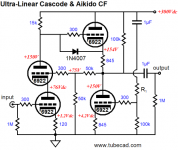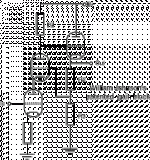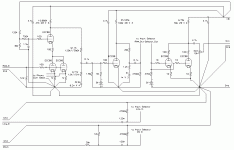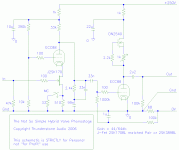Yeah, they sure do...But it's and Orange Glow, not a Green One...Funny you should bring that up..I've been Rolling these, and having a separate DC Heater Supply, I just turn the B+ Off and Pull a Tube...And they will Lay there, beside the Amp with a Fading Orange Glow..
If you're refering to Tube Dampers, than No..I can hear no need for them. But the Amp is also well away from the Speakers....Then again, these are Soviet Mil. Spec. and could probably handle a Nearby 10 Megaton Strike....That would be the 6N23P-EV's.....Check the Specs...
No, I don't mean dampers. I mean parasitic oscillations, which can plague 6DJ8s and other high Gm tubes unless stopper resistora are used.
Talking of ecc88 tubes, I'm trying to find a very high gain stage with an ouput buffer for low z output using these, from B+ 250v
I can find a cascode + aikido (sp) but that uses 2 envelopes (4 triodes) - is there any other low distortion all tube method that uses only 3 triodes or less?
I did wonder about a cascode + high current output in the style of the tacotta with a simple low gain output - with main resistance in the anode.
I can find a cascode + aikido (sp) but that uses 2 envelopes (4 triodes) - is there any other low distortion all tube method that uses only 3 triodes or less?
I did wonder about a cascode + high current output in the style of the tacotta with a simple low gain output - with main resistance in the anode.
Hi Globulator, seems to me a cascode would get you the gain and this could be followed by a simple cathode follower.
Hi Globulator, seems to me a cascode would get you the gain and this could be followed by a simple cathode follower.
I think that is ideal, except CFs are supposed to sound very weird/bad when you start to load them up too much - which is why to many top top hi-end designs go with something else to drive cables, power amps etc.
Problem is I have loads of ECC88s, but no transformers and no wish to add silicon, the attached diagram could be modded for 250V (and there are output stages from Allen Wright too) but they all use up tubes so I'd end up with a 5 tube DIY phono stage, rather than a 4 tube one.
I guess the question is: "Is there a way to implement a very linear high gain stage with low output Z with only 3 ECC88 triodes, avoiding the CF topology?" !
There is a William Johnson block (2nd attachment) from here that may do it, or I could just use a heavy end stage in a single triode like a watered down toccata (3rd attachment).
Attachments
I think that is ideal, except CFs are supposed to sound very weird/bad when you start to load them up too much - which is why to many top top hi-end designs go with something else to drive cables, power amps etc.
I'm sorry, that just doesn't make any sense to me. First, ANY circuit will sound "weird/bad" when driving loads outside of its design range. Second, what sort of load would a phono preamp see? 10k? 1000pF? Trivial for a plain vanilla ECC88. If for some perverse reason one wanted to drive a 600R load with 1uF across it, ANY basic preamp circuit will fold up; the designer would then need to use a bigger, higher current output stage, regardless of the topology. There's nothing special about a CF in this context.
Fortunately, the worries here are inappropriate. A power amp (or line stage) with even 5m runs of high capacitance interconnect is just not a terribly onderous load.
Fortunately, the worries here are inappropriate. A power amp (or line stage) with even 5m runs of high capacitance interconnect is just not a terribly onerous load.
OK I hear what you are saying, it seems like more a case of choosing the right tube for the job, and the Ecc88 will drive a power amp or pre-amp input with ease in (almost) any topology.
In that case I guess the output of the attached circuit would be strong enough on its own?
The attached schematic is referenced from here and caught my eye because it uses an ecc88, the B+ matches what I have available (250V) and it uses no loop feedback, plus the input stage is also similar to Allen Wright's.
The only thing putting me off trying this is the mosfet current source on the output stage, can you suggest a tube current source (or better?) using 1 or 2 triodes of an ecc88 to replace that?
Oh and I would also want to put a 96R resistor in series with the vertical 33n capacitor (that's parallel to the 2.4k) to give the missing 3.18uS time constant - does that sound like the right value and place?
Attachments
the Ecc88 will drive a power amp or pre-amp input with ease in (almost) any topology.
I can't agree with that; as a common cathode amplifier, the distortion with a 10k load will be significant- not high, but significant. But it certainly can in cathode follower, White cathode follower, mu follower, bootstrapped CF, and other low impedance modes.
The MOSFET CCS in your schematic is not optimal. For the cost of one additional FET (about a buck), you can cascode them, making the CCS performance insanely good, far better than a tube can do there. The terminating load will absolutely dominate- the CCS will be out of the picture at AC. Source impedance will be roughly the plate resistance of the ECC88, low enough for light loads and short cables.
Using a 96R will get you that "missing" time constant, but you may have to trim some of the other components to restore RIAA accuracy within the audible band.
I can't agree with that; as a common cathode amplifier, the distortion with a 10k load will be significant- not high, but significant. But it certainly can in cathode follower, White cathode follower, mu follower, bootstrapped CF, and other low impedance modes.
The MOSFET CCS in your schematic is not optimal. For the cost of one additional FET (about a buck), you can cascode them, making the CCS performance insanely good, far better than a tube can do there. The terminating load will absolutely dominate- the CCS will be out of the picture at AC. Source impedance will be roughly the plate resistance of the ECC88, low enough for light loads and short cables.
Using a 96R will get you that "missing" time constant, but you may have to trim some of the other components to restore RIAA accuracy within the audible band.
I guess you are saying that triodes make worse CCS than silicon?
I see you have discussed CCS applications with BJTs earlier, so I can see how to implement that - better than mosfets too as I cannot blow them up with static and they are cheaper 🙂
If you were making this - what current would you aim for through the final stage? I guess it affects the 68R resistor too for the biasing, although if pressed I could use a 3V lithium for that to lock it down.
I think the load will be 100k to 50k on the end of this via a short cable.
[Regarding the RIAA - thanks for confirming and noting I need to re-check the overall response. I may have to do that by listening only but all noted!]
Thorsten would be better situated to give you optimal operating points- it's his circuit. In my phono stage, I use 10mA though the ECC88.
FWIW, I have not blown up any of the DN2540 with static, only with the same sort of stupidity I've successfully used in the past to turn bipolar silicon transistors into inert lumps of carbon and slag. Don't fear the FET.
FWIW, I have not blown up any of the DN2540 with static, only with the same sort of stupidity I've successfully used in the past to turn bipolar silicon transistors into inert lumps of carbon and slag. Don't fear the FET.
Thorsten would be better situated to give you optimal operating points- it's his circuit. In my phono stage, I use 10mA though the ECC88.
Did I read somewhere that you were going to publish your phono stage circuit at some point? I'd love to see the schematics - I'm still (as you must be painfully aware 😉) trying to make the perfect tube phono stage without actually knowing much about the various topologies or tubes 😉
My requirements are: MC 0.2mV low noise, no multi-stage feedback, must use 250V and ecc88 (as I have those), be fairly accurate RIAA (inc 3.18), use 3 or 4 envelopes, must drive 50k load with ease.
Yes, it will be in the Articles section of this website very shortly. It will not be popular.😀
It will, however, meet your requirements (though you'll still have to buy a couple more tubes). And if you follow the advice on interconnect wiring, you'll find it remarkably quiet.
It will, however, meet your requirements (though you'll still have to buy a couple more tubes). And if you follow the advice on interconnect wiring, you'll find it remarkably quiet.
Yes, it will be in the Articles section of this website very shortly. It will not be popular.😀
Not popular? I detect some solid state 😉
The reason for 3-4 envelopes is for space, power and time-to-build reasons, I've actually got over 20 ecc88s lying about begging to be used !!! Yes, I too once had an old tektronix scope!
It's funny but the input seems to be fairly well solved with the Jfet/ecc88 cascode, just the output raising a few questions. I'm looking forward to your take on this!
Once I've fixed the number of envelopes to use I can punch the holes for the bases 🙂. Well - it's a start....
Wow - that was a fast reply!!!
4 envelopes sounds perfect, neons even more so, especially as I have a bunch of those too (er... also off my old tektronix 545b - sort of like a store-room, even comes with a time-delay warmup bimetallic tube switch)..
Please feel free to PM me any details if you find the article taking too long to complete 🙂
4 envelopes sounds perfect, neons even more so, especially as I have a bunch of those too (er... also off my old tektronix 545b - sort of like a store-room, even comes with a time-delay warmup bimetallic tube switch)..
Please feel free to PM me any details if you find the article taking too long to complete 🙂
So to steer this thread back to the beginning...bottom line is that the 6DJ8 is a fine current production tube...so fine that no one really bothers to talk about it much anymore.
So with that said, what 6922/6DJ8 tubes are folks buying? There still seems to be a lot of JAN tubes floating around. Some preference towards the 70s vintage Sylvanias has been noted compared to the PhilipsECG stuff (not sure why). Then there is JJ, but I am a little skeptical about them at the moment. Then there is New sensor stuff...Sovtek and EH. Prices shoot up quickly for other NOS examples unless you roll the dice on eBay.
Looking at my stock, I have a few JJs and a few PhilipsECG JAN tubes. I think I was going to build a headphone amp or something. Probably Mr. Jones again.
So with that said, what 6922/6DJ8 tubes are folks buying? There still seems to be a lot of JAN tubes floating around. Some preference towards the 70s vintage Sylvanias has been noted compared to the PhilipsECG stuff (not sure why). Then there is JJ, but I am a little skeptical about them at the moment. Then there is New sensor stuff...Sovtek and EH. Prices shoot up quickly for other NOS examples unless you roll the dice on eBay.
Looking at my stock, I have a few JJs and a few PhilipsECG JAN tubes. I think I was going to build a headphone amp or something. Probably Mr. Jones again.
Last edited:
So from the lack of responses, I will assume that all 6DJ8s and 6922s are really great. That's good news!
So from the lack of responses, I will assume that all 6DJ8s and 6922s are really great. That's good news!
Or those of us who use them don't want to have to compete with others for the "good stuff." 😀
- Status
- Not open for further replies.
- Home
- Amplifiers
- Tubes / Valves
- Morgan Jones and the ECC88/6922/6DJ8



